Water caltrop
{{{name}}} Trapa
|
water caltrop, water chestnut
| ||||||||||||||||||||||||||||||||||||||||
|---|---|---|---|---|---|---|---|---|---|---|---|---|---|---|---|---|---|---|---|---|---|---|---|---|---|---|---|---|---|---|---|---|---|---|---|---|---|---|---|---|---|

|
|
| |||||||||||||||||||||||||||||||||||||||
| |||||||||||||||||||||||||||||||||||||||||
| Standard Cyclopedia of Horticulture |
|---|
|
Trapa (abbreviated from calcitrapa, which is the same as caltrops, an instrument of war used to impede the progress of mounted warriors; it had four spine-like projections, like the fruit of the water caltrops). Trapaceae or Hydrocaryaceae; by some retained in Onagraceae. Floating plants adapted to the aquarium. Flowers small, axillary, solitary, short-peduncled; calyx 4-parted, the segms. persistent, sometimes spinescent; petals and stamens 4; ovary 2-loculed; ovules solitary, long, pendulous, affixed to the septum: fr. top-shaped, leathery or somewhat bony, 1-loculed, 1-seeded.—Three species, native to the warmer parts of the eastern hemisphere. Trapa natans is one of the daintiest aquatics in cultivation. It is perfectly hardy and very desirable for aquaria, pools, ponds, or tub-culture. Its beautifully mottled or variegated foliage is very attractive. The flowers are white, small, and inconspicuous. The fruits are very large in comparison with the flowers and leaves, but they are hidden beneath the foliage until they ripen, when they drop off. They are good to eat raw, like chestnuts, and are sweeter and more palatable before the shell becomes hard. The nut is not likely to become of commercial importance in America. The seeds drop from the plant and remain in the pond all winter. Seeds must be kept in water or moist to retain their vitality. T. bicornis, Linn. f., the Ling of China, is by some referred to T. natans: the fr. has 2 strong opposite long decurved horns like those of a bull's head. CH
|
Cultivation
- Do you have cultivation info on this plant? Edit this section!
Propagation
- Do you have propagation info on this plant? Edit this section!
Pests and diseases
- Do you have pest and disease info on this plant? Edit this section!
Species
Gallery
If you have a photo of this plant, please upload it! Plus, there may be other photos available for you to add.
-
photo 1
-
photo 2
-
photo 3
References
- Standard Cyclopedia of Horticulture, by L. H. Bailey, MacMillan Co., 1963
External links
- w:Water caltrop. Some of the material on this page may be from Wikipedia, under the Creative Commons license.
- Water caltrop QR Code (Size 50, 100, 200, 500)
